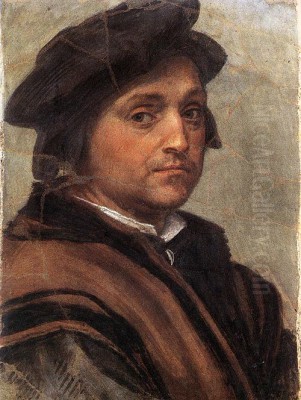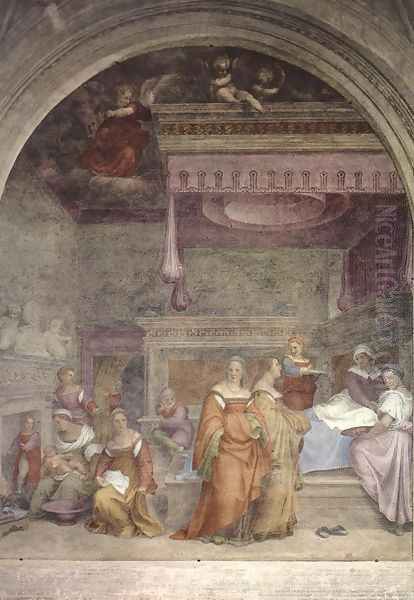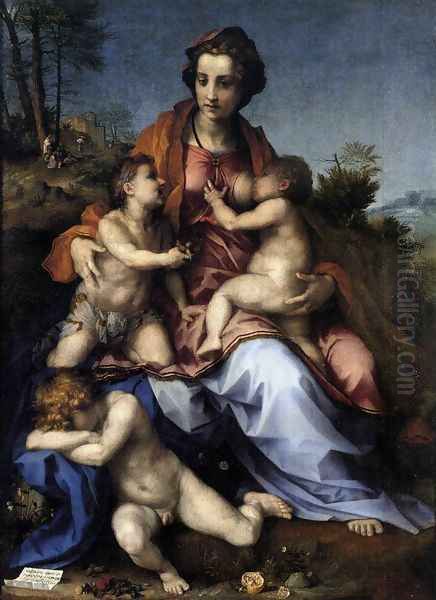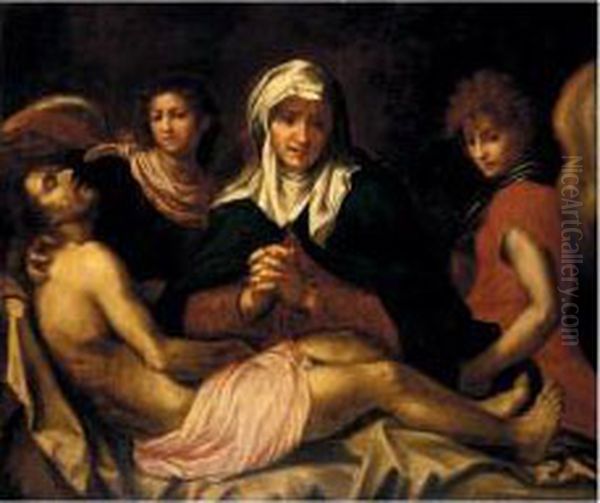
Andrea del Sarto stands as one of the preeminent figures of the Florentine High Renaissance, a master painter whose technical brilliance earned him the moniker "Senza Errori" – the faultless painter. Born Andrea d'Agnolo di Francesco di Luca di Paolo del Migliore Vannucchi in Florence on July 16, 1486, he became known as Andrea del Sarto because his father, Agnolo, was a tailor (sarto). Active during a period dominated by giants like Leonardo da Vinci, Michelangelo, and Raphael, Sarto carved out a distinct and influential path, celebrated for his harmonious compositions, sophisticated use of color and light, and deeply felt religious works, particularly his frescoes. Though sometimes overshadowed by his more famous contemporaries, his art represents a pinnacle of Florentine classicism and served as a crucial bridge to the subsequent Mannerist style, influencing a generation of artists through his busy workshop.
Early Life and Artistic Formation
Andrea del Sarto's journey into art began not with a brush, but perhaps with metal. Some accounts suggest an early apprenticeship as a goldsmith around 1494, a common starting point for Florentine artists that instilled a sense of precision and design. However, his talent for drawing soon led him towards painting. He entered the workshop of Gian Barile, a painter and woodcarver, where he likely honed his foundational skills.
His formal training progressed under the guidance of more established masters. He spent time learning from Piero di Cosimo, an eccentric but highly imaginative painter known for his mythological scenes. This period exposed Sarto to a different sensibility, perhaps fostering his narrative skills. He also studied with Raffaellino del Garbo, a painter working in the refined, slightly archaic style derived from Filippino Lippi and Perugino. Through these apprenticeships, Sarto absorbed the core tenets of Florentine design (disegno), emphasizing strong draftsmanship and clear structure.

By around 1508, Sarto was ready to establish himself independently. He formed a partnership with a slightly older painter, Franciabigio, who had trained with Mariotto Albertinelli, himself a partner of Fra Bartolommeo. They shared a workshop near the Piazza del Grano and collaborated on some works, though their styles remained distinct. This period marked Sarto's emergence as a mature artist ready to undertake significant commissions.
Rise to Prominence: Frescoes and Early Masterpieces
Sarto's reputation grew rapidly, largely through major fresco cycles commissioned by Florentine religious orders. His first significant independent commission came around 1509-1510 from the Servite Order for the entrance cloister (Chiostrino dei Voti) of their church, Santissima Annunziata. Here, he painted five frescoes depicting scenes from the life of Saint Philip Benizi, the founder of the Servite Order. These works already displayed his characteristic grace, balanced composition, and ability to render naturalistic figures and drapery.
He returned to the Chiostrino dei Voti shortly after, around 1511, to paint the Procession of the Magi, a work demonstrating his growing confidence and ability to handle complex multi-figure compositions. Perhaps his most celebrated fresco in this location is the Birth of the Virgin, completed by 1514. This work is lauded for its harmonious arrangement, rich color, atmospheric depth, and the gentle, human quality of the figures, showcasing Sarto's mastery in blending High Renaissance ideals of balance and naturalism with a palpable emotional warmth.
Contemporaneously, Sarto began another major fresco project, this time for the Confraternity of the Scalzo in Florence. Between roughly 1511 and 1526 (with interruptions), he executed a series of twelve large frescoes depicting the Life of St. John the Baptist in the confraternity's cloister (Chiostro dello Scalzo). Unusually, these were painted almost entirely in monochrome (grisaille), imitating stone reliefs. This demanding technique highlighted Sarto's exceptional draftsmanship and his sophisticated control over light and shadow (chiaroscuro) to create volume and drama without relying on color. The Scalzo cycle stands as a testament to his technical virtuosity and narrative power.
Masterworks and Signature Style
While renowned for his frescoes, Andrea del Sarto was equally adept at panel painting, producing altarpieces and devotional works that cemented his status. Among his most famous panel paintings is the Madonna of the Harpies, commissioned for the high altar of the church of San Francesco dei Macci and completed in 1517 (now in the Uffizi Gallery, Florence). The painting depicts the Virgin and Child enthroned between St. Francis and St. John the Evangelist. The enigmatic sculpted harpies on the pedestal give the work its name.

The Madonna of the Harpies is often considered a quintessential work of the Florentine High Renaissance. It masterfully synthesizes the influences Sarto absorbed: the soft modeling and atmospheric haze (sfumato) reminiscent of Leonardo da Vinci, the compositional harmony and idealized grace associated with Raphael, and the sculptural monumentality and physical presence echoing Michelangelo. Yet, the work possesses Sarto's unique sensibility – a quiet emotional depth, exquisitely rendered textures, and a subtle, almost melancholic beauty in the figures' expressions. The color palette is rich and balanced, demonstrating his skill as a colorist.
Another landmark work is the fresco Madonna del Sacco (Madonna of the Sack), painted in 1525 over the entrance to the great cloister of Santissima Annunziata. Depicting the Holy Family resting during the flight into Egypt, with Joseph leaning on a sack, it is celebrated for its informal yet perfectly balanced composition, monumental figures rendered with effortless grace, and masterful handling of light and color. Giorgio Vasari, the artist and biographer who studied with Sarto, considered it his finest fresco, praising its flawless drawing, sublime grace, and vivid colors.
Sarto's style is characterized by several key elements. He perfected a soft, atmospheric chiaroscuro, bathing his scenes in a gentle light that unified the composition and enhanced the emotional mood. His color harmonies were sophisticated, often employing subtle shifts in tone (cangiante) and rich, saturated hues that avoided harshness. His compositions, whether complex narratives or intimate devotional scenes, always maintained a sense of balance and clarity. Figures possess a natural elegance and psychological presence, conveying emotion with subtlety rather than overt drama. He achieved a remarkable synthesis of naturalism and idealization, grounding sacred figures in believable human form and emotion.
The French Interlude and Return to Florence
Sarto's fame reached beyond Italy. In 1518, he was invited to the court of King Francis I of France, a great patron of Italian Renaissance art who had previously employed Leonardo da Vinci. Sarto traveled to Fontainebleau, leaving his wife, Lucrezia del Fede, whom he had married around 1517-1518, in Florence. During his time in France, which lasted less than a year, he executed several works for the king, most notably the large panel painting Charity (now in the Louvre, Paris). This work, with its pyramidal composition and tender depiction of maternal love, reflects the influence of both Leonardo and Raphael.

His French sojourn ended abruptly. According to Vasari's account, Sarto persuaded Francis I to allow him to return to Florence briefly, promising to come back with more artworks and perhaps even lure other artists to France. The king entrusted him with a large sum of money for acquiring Italian art. However, Vasari claims that upon returning to Florence and reuniting with his wife, Sarto used the funds to build himself a house and never returned to France, damaging his reputation and relationship with the French king. While the exact details and extent of any wrongdoing are debated by modern historians, the story, whether entirely true or embellished, highlights the complex interplay between artistic patronage, personal life, and reputation in the Renaissance. Lucrezia, often depicted as a demanding figure in Vasari's narrative and later in Robert Browning's famous poem, certainly played a significant role in his life and frequently served as a model for his female figures.
Later Years, San Salvi, and the Scalzo Cycle Completion
Back in Florence from 1519, Sarto resumed his prolific career. He continued work on the Chiostro dello Scalzo frescoes, completing the cycle by 1526 with scenes like the Birth of the Baptist, Visitation, and Beheading of the Baptist. These later works show an increasing complexity and dynamism, perhaps reflecting the emerging Mannerist tendencies.
During the 1520s, he produced several major altarpieces, including the Panciatichi Assumption (c. 1522-23) and the Passerini Assumption (c. 1526), both now in the Pitti Palace, Florence. These large-scale works demonstrate his continued mastery of complex compositions and rich color. He also painted the moving Pietà (c. 1523-24, Pitti Palace), notable for its intense emotional expression and dramatic lighting.
One of his most significant late works is the Last Supper fresco (c. 1520-1527) in the refectory of the monastery of San Salvi, just outside Florence's walls. Unlike Leonardo's famous depiction of the dramatic moment of betrayal, Sarto chose a calmer, more contemplative moment, focusing on the institution of the Eucharist. The work is admired for its balanced composition, realistic detail (especially the still life elements on the table), psychological insight into the apostles, and masterful handling of light flooding the scene. During the Siege of Florence in 1529-1530, soldiers destroying surrounding buildings reportedly spared the refectory out of admiration for this fresco, a testament to its perceived power and beauty even then.
The siege and the subsequent outbreak of plague marked Sarto's final years. He reportedly retreated to the Mugello region to escape the plague but eventually succumbed to it in Florence, dying on September 29, 1530, at the relatively young age of 44.
Workshop, Pupils, and Influence
Andrea del Sarto ran one of the most important and productive workshops in Florence during the 1510s and 1520s. He was a highly sought-after teacher, and his studio became a training ground for the next generation of Florentine painters, many of whom would become leading figures of Mannerism.

His most famous pupils were Jacopo da Pontormo and Rosso Fiorentino. Both artists absorbed Sarto's technical brilliance, his sophisticated use of color, and his elegant draftsmanship, but they pushed these elements in new directions. Pontormo developed a highly personal style characterized by elongated figures, unsettling spatial arrangements, and intense, often acidic colors, exploring complex psychological states. Rosso Fiorentino shared Pontormo's interest in expressive distortion and vibrant color but developed a more dynamic and sometimes eccentric style, eventually working in France alongside Francesco Primaticcio at Fontainebleau.
Another significant figure associated with Sarto's workshop was Giorgio Vasari. Though perhaps more famous today for his Lives of the Most Excellent Painters, Sculptors, and Architects, Vasari was also a painter who deeply admired Sarto and briefly studied with him. His biography of Sarto remains a primary, albeit biased, source of information about the artist's life and work.
Other artists who passed through Sarto's circle include Francesco Salviati, who became known for his elegant and decorative Mannerist style, and possibly Jacopino del Conte. Andrea Sguazzella was another pupil who later worked in France. Sarto's early partner, Franciabigio, also remained a significant figure in the Florentine scene. The influence of Sarto's balanced classicism, combined with his subtle emotional depth and technical refinement, provided a crucial foundation upon which these younger artists built their more stylized and expressive Mannerist experiments. His impact extended beyond his direct pupils, influencing the broader course of Florentine painting in the 16th century. He also looked up to contemporaries like Fra Bartolommeo, whose monumental style influenced his own altarpieces.
Critical Reception and Legacy
Andrea del Sarto's reputation has navigated a complex course. During his lifetime, he was highly esteemed, receiving major commissions and recognition as a leading master in Florence, a city teeming with artistic talent. His technical perfection earned him the "faultless painter" nickname, signifying admiration for his seemingly effortless mastery of drawing, color, and composition.
However, posthumously, his fame became somewhat eclipsed by the towering figures of Leonardo, Michelangelo, and Raphael. Giorgio Vasari, while praising Sarto's technical skill and the beauty of his works, famously criticized him for a perceived lack of "fire," ambition, and divine inspiration compared to the "Big Three." Vasari attributed this supposed timidity partly to the influence of Sarto's wife, Lucrezia, portraying him as overly constrained by personal affairs. This assessment, colored by Vasari's own biases and narrative aims, proved highly influential for centuries.

Robert Browning's dramatic monologue "Andrea del Sarto (Called 'The Faultless Painter')" published in 1855, further cemented this image of a technically perfect but ultimately unfulfilled artist, lamenting his inability to reach the sublime heights of Raphael or Michelangelo, partly blaming his wife's earthliness for clipping his artistic wings. The poem, while a powerful work of literature, reinforced a somewhat tragic view of Sarto's career.
In the 20th and 21st centuries, art historians have largely revised this perspective. While acknowledging that Sarto's art may not possess the revolutionary impact of Leonardo or the overwhelming power (terribilità) of Michelangelo, scholars now emphasize his unique strengths and historical importance. His synthesis of High Renaissance ideals with a deeply personal sensitivity, his mastery of fresco and panel painting, his influential role as a teacher, and his crucial position as a bridge between the classicism of Raphael and the emerging Mannerism of Pontormo and Rosso are now fully recognized.
Exhibitions and scholarly studies have highlighted his exceptional skill as a draftsman, his innovative use of color and atmospheric effects, and the profound, quiet emotion conveyed in his works. The controversies surrounding his personal life and Vasari's assessment are now viewed more critically, allowing for a more balanced appreciation of his artistic achievements. He is firmly established as a central figure in the Florentine High Renaissance, an artist whose "faultless" technique served a vision of grace, harmony, and subtle human feeling.
Conclusion: The Enduring Harmony of Sarto
Andrea del Sarto's legacy is that of a consummate master whose art embodies the grace, balance, and technical refinement of the Florentine High Renaissance at its peak. While navigating a world populated by artistic titans, he forged a distinctive style characterized by harmonious compositions, luminous color, soft atmospheric effects, and a gentle, pervasive humanity. His frescoes for Santissima Annunziata and the Chiostro dello Scalzo, along with masterpieces like the Madonna of the Harpies and the San Salvi Last Supper, remain enduring testaments to his skill.
Though his reputation was shaped, and perhaps unfairly limited, by Vasari's influential critique and later literary interpretations, modern appreciation recognizes the profound quality and historical significance of his work. As a pivotal teacher, he nurtured the talents that would define Florentine Mannerism, making his workshop a crucible for artistic innovation. Andrea del Sarto, the "faultless painter," ultimately offers a vision of serene beauty and technical perfection, securing his place as an indispensable figure in the rich tapestry of Italian Renaissance art.